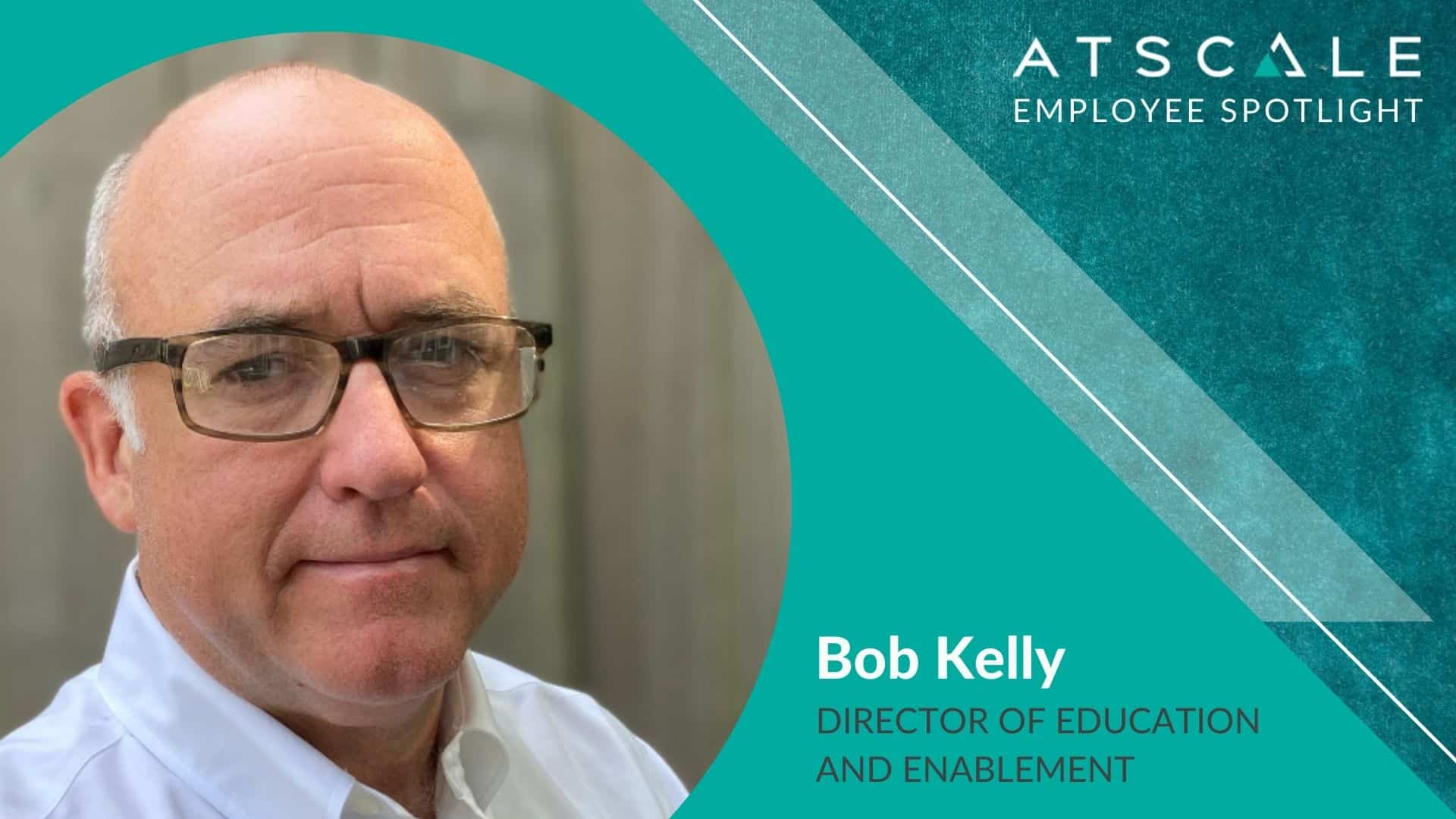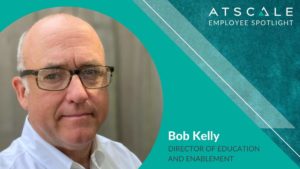November 19, 2019
Employee Spotlight: Martin Carrillo

With the summer season coming to an end, students of all levels are preparing to return to the classroom. For our customers, AtScale University has online classes in session all day, every day. Who is their instructor? Today, we are pleased to introduce you to Bob Kelly, Director of Education and Enablement, here at AtScale.
What is your role at AtScale? What excites you most about working here?
A: I am Director of Education and Enablement. The thing that excites me the most about my role at AtScale University is watching my students have that “ah-ha” moment or when they learn something that helps them use AtScale and do their job. Students typically start with the AtScale Essentials class where we teach the basics of AtScale and show them how it actually works. For most students, they’ve seen the marketing and the demos, but they really haven’t gotten to do it themselves. Through our online classes, they get to watch how AtScale can make a query run faster and then try it themselves. Sometimes, an administrator or an expert knows AtScale, but not how to do this one technique and I get to show that to them and I get to be there when they discover new things. The most exciting part of my job is being a part of those moments.
I should say that I’m not a teacher. I’ve been a field services person for my entire career. When I joined AtScale, I was the first field services person. I was the first person ever allowed to install the product. Before I joined, only engineers were installing the AtScale product. I have a long background in UNIX, databases and business intelligence systems and I quickly showed the folks on the engineering side that I was capable of installing the product. This kind of evolved to where I was developing training because customers wanted it and that’s what you do in field services. This turned into management approaching me to let me know that we had great feedback from customers who love learning from me and asking if I would focus on educating customers to use AtScale full time. I gladly accepted and this is where I am today. I never really got to see those teaching moments in field services so it’s been really cool to be a part of that process. I normally would solve the problem and then leave. Now, I get to show people the product and watch them learn. It’s something that I hope to continue to do, it’s been great!
So there was a real need for training courses?
A: Yes, it became a natural fit. That’s how I continue to build my training. We have a class called “Aggregates in Action” and in that course, it’s me taking all of the knowledge of aggregates and how they work and I built that into a training. It’s been really great. It was a natural fit for me using my field services skills and building a training around it.
What does a “day in the life” look like for you?
A: A typical day will involve some sort of training. In the past, it would’ve been me traveling a lot. Before COVID-19, I traveled around the world, visiting customers and delivering training to them. Now, post-COVID, a “day in the life” is me having instructor-led training via Zoom where I speak with customers and deliver one of my training or workshops. On a different day, I do a lot of work on developing new videos and creating new content. Once a quarter, I modify the training for the latest version of our product.
How did you get your start working in business intelligence/data analytics?
A: I’ve been working in business intelligence (BI) and data analytics for 27 years, my entire career has been BI. I started off working on the first BI tool for windows. When I started, Windows 3.0 (the first release of Windows) was released and there was one tool called Crystal Reports that was really the first BI tool on Windows. There was also another tool called Forest and Trees. I joined a couple of gentlemen and we were implementing Forest and Trees as the sole implementers and it was really magical. You could build a dropdown list box based on SQL query. This was groundbreaking! At the time, It was the coolest thing ever. I could query a database and get the distinct values from a table and I could put them in a dropdown list box and the report would change. It’s a simple and expected feature today, but it was a really big deal back then.
Prior to working at AtScale, you’ve held leadership positions at several other companies. At Active Interest, you were the President, CEO and a Systems Architect. Can you speak to that experience?
A: After working at the consulting agency Browning and Clements, We created a firm utilizing concepts from Kimball and Inmon in their groundbreaking data warehouse toolkit that changed the whole paradigm of data warehousing. Prior to Kimball and Inmon we actually did reporting on the systems that were designed for the input. Basically a system was “highly normalized” meaning that it is designed for inserting data into the database. When we ran our reports, we would run off of the system that already existed and it was slow. With these new concepts, we were moving data and replicating it for reporting. This ability was enabled by some important things happening at the time. For example, disk space and computers were starting to get cheaper. It was actually feasible for a company to take their data and move it from the operational system into a data warehouse designed specifically for analytics. That was the advent of the data warehouse. When we moved that data, we “denormalized” it creating a star schema. I decided to start a company based on Kimball’s new principle of data warehousing. That was Active Interest. Everybody was reporting directly off of the operational systems and this new idea of moving data into the data warehouse, denormalizing it and making it faster for reporting was all new. This was a very exciting time in the world of analytics and warehousing.
Can you talk to us about AtScale University? What can customers expect to learn from the courses?
A: AtScale University is the education arm of AtScale. Folks should expect to learn everything they need to know about AtScale to use it. Starting with “AtScale Essentials,” you learn the basics of AtScale and how it works. In “Advanced Cube Design,” you learn how to augment those processes and to do some more practical and real-world concepts. Typically our customers would never go to production with a cube similar to what we would build in the Essentials class. Most of our customers would have cubes that are in the concepts of the AtScale Advanced Cube Design class. We have administration classes that teach the system administrators to install, update, back up and recover AtScale and to do all of the administration activities in the AtScale servers. We also have several workshop classes that go into better detail. In one workshop we look at time relative data and how to do that type of activity inside of AtScale. In another workshop we look at aggregates and how to manage the aggregate system and better tune the system for aggregates.
Describe AtScale in three words.
A: Run, Queries, Faster.
What makes AtScale and our solution unique?
A: What I loved from the beginning of working here was making queries run faster. My whole professional life has been about making queries run faster. And this is the reason why I came to AtScale. I also love the fact that we utilize a star schema. I never thought that the Kimball and Inmon modeling that I did early in my career would come back in such an important way. I think another reason is that I’ve been trying to federate data for my entire career. The BI user wants to query multiple data sources today more than ever with these big Hadoop warehouses and operational systems. In the past, we (data warehousing professionals) have forced our customers to do that in the ETL process. We forced them to move data into one place and at the same time combine that data. Our ability at AtScale to federate data is by far a differentiator. It’s one of the most unique and exciting solutions in the market. I love a lot of features that we have but for me the federation is the most exciting and what makes us most unique.
When you’re not in the office, how do you like to spend your free time?
A: I like to do anything outdoors. I am an avid skier, hopefully we get to ski this year!
Thank you, Bob! Interested in meeting the rest of the team? Keep an eye out for our next employee spotlight, here on our blog!
Check out our past interviews:
NEW BOOK